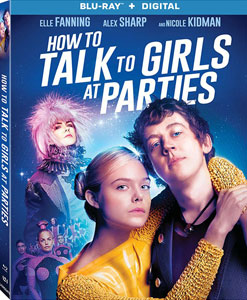If not for “Annihilation,” “How to Talk to Girls at Parties” would rank as the weirdest sci-fi movie of the year. The central premise isn’t all that crazy, though: Guys talk to girls at a party, and the girls are actually aliens. Within the confines of this idea, the film finds its cutest and most relatable moments, as human Enn (Alex Sharp) and alien Zan (Elle Fanning) warm up to each other. Unfortunately, other parts of the movie are far too alien.
Based on a 2006 Neil Gaiman short story, “HTTTGAP” – now available via Amazon Prime — is set during the 1977 rise-of-punk era in the crumbling Croydon area of London. Effective touches bring us into this period, including the fact that Enn publishes a punk fanzine along with his buddies Vic (AJ Lewis) and John (Ethan Lawrence).
Searching for a party after a show, the lads instead find a building that houses an alien collective. They assume it’s a punk party, and at any rate, there are cute girls in skin-tight outfits there. Splitting the punk ethos into its component parts, Vic has the vague notion that there’s sex to be had at the party, John is interested in the cult’s music stylings, and Enn connects with Zan. The lads’ encounters with the aliens are played flatly, rather than with a “Shaun of the Dead” sense of humor about the whole thing, and that keeps the audience at a “What the heck am I watching?” distance.
Zan, for her part, is inspired by punk to rebel against her rigid, collective society. Outfits and body language emphasize Fanning’s long neck, making her seem somewhat alien. Zan’s behavior is also a hint; indeed, she openly admits she is adjusting to this body. At first, Enn assumes she’s a quirky Californian, then gradually realizes she’s an alien, but his interest in her doesn’t diminish – after all, Zan is his first love.
The problem with “HTTTGAP” – directed by John Cameron Mitchell and written by Mitchell and Philippa Goslett – is all the time spent outside the engaging Enn-Zan relationship. Too much time is spent on the details of the alien collective’s culture, yet they remain bizarre and confusing – although we certainly can glean the broad point that it’s not a great structure for youth to grow up in.
The punk club scenes are nearly as alien – which I suspect is the point – as Queen Boadicea (Nicole Kidman, for some bizarre reason) controls the stage time in search of the next big star, and the punk rockers never grasp the irony. These scenes are at least more fun than the alien scenes, particularly when Zan is gussied up in punk stylings such as black eyeshadow and thrown on stage without a song to sing. So she yells the story of her race’s history, and it comes off as an epic punk tune; she’s the new star, at least for 15 minutes.
Despite its rich themes and amusing parallels between an alien collective and 1970s Great Britain, “HTTTGAP” never quite jells, and it doesn’t stick its landing. Despite the collective serving as a metaphor for Earth society, the writers cling to one sketchy rule about alien physiology that makes a happily-ever-after almost impossible.
And, indeed, the whole picture remains slightly out of a viewer’s grasp. While it nicely brings us into the vintage punk era, the alien collective always halts the momentum, and the film could use about twice as many Zan-and-Enn scenes. Much more theme-oriented than character- or plot-oriented, “HTTTGAP” is a more interesting film to discuss than it is to watch.


